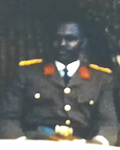Top Qs
Timeline
Chat
Perspective
List of presidents of Burundi
From Wikipedia, the free encyclopedia
Remove ads
The president of Burundi is the head of state and head of government of the Republic of Burundi. The president is also commander-in-chief of the National Defence Force. The office of the presidency was established when Michel Micombero declared Burundi a republic on 28 November 1966.[3] The first constitution to specify the powers and duties of the president was the constitution of 1974, which was adopted in 1976.[4] Written by Micombero, the constitution affirmed his position as the first president of Burundi.[2] The powers of the president derive from the latest constitution, implemented in 2005 as a result of the 2000 Arusha Accords after the Burundian Civil War.[4]
Remove ads
The president's stated role is to represent Burundi's national unity and ensure that the laws and functions of the state are created and executed with full compliance of the constitution. The president has the power to appoint military commanders, ambassadors, magistrates and provincial governors. The president also appoints all judges, including those of the Supreme Court and the Constitutional Court. The president can organize government and can call for parliamentary sessions under extraordinary circumstances. In addition to promulgating legislation, the president has the power to propose and amend laws, and can veto laws passed by the parliament. A presidential term is seven years,[1] and presidents can serve a maximum of two terms.[5][a] The president is entitled to a pension after the end of their final term of office.[2]
Nine people have served in the office since Burundi became a republic. Only one president, Pierre Buyoya, has served on two non-consecutive occasions.[7] Sylvie Kinigi was the first and only woman who has served in the role (on an interim basis).[8] The current president, Évariste Ndayishimiye, has been serving in the role since 18 June 2020.
Remove ads
List of officeholders
Summarize
Perspective
- Political parties
- Status
- Symbols
† Died in office
Remove ads
Timeline

See also
Notes
- Pierre Nkurunziza was elected for a third term, as the Constitutional Court considered that his first, indirectly elected term, did not count towards the limit.[6]
- On 21 October 1993 President Ndadaye and several other officials were killed by Tutsi soldiers in a coup attempt, leaving Prime Minister Kinigi the highest-ranking official alive and the de facto head of state of Burundi. Kinigi joined her surviving ministers in the French embassy until she could return to her residence under French military guard as the coup failed.
- On 8 November 1993 the Constitutional Court ruled that "the government acting collegially" assumed the responsibilities of the interim presidency until a new president could be elected.[14]
Remove ads
References
Wikiwand - on
Seamless Wikipedia browsing. On steroids.
Remove ads













